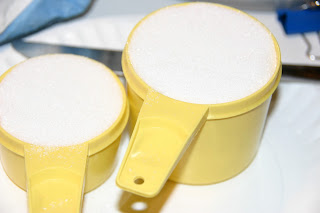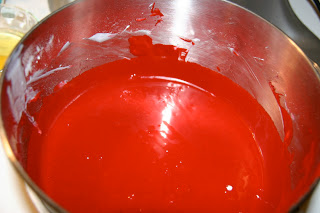Not every morning can be mellow. The rapid-fire pace of life demands that most days' nourishment (and I use that term lightly) begins with something perfunctory, scarfed from a package or slurped quickly from a bowl. I am of the opinion that a good breakfast, the kind you share with others on a weekend or holiday, presents some of life's finest moments. The breakfast table is one of my happy places!
I grew up with leisurely Saturday morning breakfasts, catered mid-morning to a houseful of late sleepers. My mom to this day makes magic biscuits and has this skillet wonder dish she calls German Farmer's Breakfast, a melange of potatoes, onions, peppers and whatever scrambled into eggs in a sort of loose frittata. And she can take an earnest package of dried beef and turn it into a gravy that is to die for. Really! But more important has been the time around the table, the connecting, the catching up, the idle conversation over cleaned plates that makes the morning happy. The food, ah the food, is a most lovely catalyst that calls folks to lounge and linger. Many weekends as I was growing up, the Lambert house resembled a loud and happy boarding house or gregarious bed and breakfast as relatives and friends found an extra bed or pull-out sofa at the ready on Friday nights, and groggily found their way to the kitchen table as the smell of hot biscuits and fresh-brewed coffee began to nudge them gently to wakefulness on Saturday morning.
This is a tradition I felt obliged to carry over to my own family. When I married Paul and the boys, I found breakfast to be the one meal where I could please everyone's palate. I was a novice at feeding young boys and I cooked a lot things that missed the mark. I could tell by the ring of detritus around the edge of the plates as I cleaned the dishes, little pieces of mushroom or onion or celery or other ingredients deemed either unidentifiable or undesirable by discerning boys. Pancakes worked 100% of the time. Bacon was always a hit. I hope now as they are older they understand food is one of the ways I have tried to show them love over the years, even though some of the attempts were questionable!
As Paul and I have become empty nesters, sharing a leisurely Saturday breakfast continues to be something we gravitate toward, a cozy respite after scattered days and schedules. And given the chance when visiting friends' homes I will volunteer to make breakfast as a sort of reverse gift of hospitality (they supply their home, I love them with breakfast!)
We have lovely friends who have allowed us to make ourselves at home at their lake house for Auburn football weekends. They share so generously of their home and their friendship. Last weekend as we settled in with them on Friday night in preparation for an epic Auburn football battle with LSU, I came prepared with Saturday breakfast. Likewise, as the holidays are fast approaching (oh, yes, faster than we can imagine) many of us will be opening our homes to friends and relatives or finding ourselves camped out on extra beds and pull-out sofas as we become the guests. Nothing says love like yeasty homemade cinnamon rolls. The smell announces good tidings way before the first roll is shared. With just a little bit of advance preparation (okay, maybe a MODERATE amount of advance preparation) you can create an environment where lounging and lingering are de rigueur.
Once again my faithful recipe hound (husband Paul) found this recipe for me and it's been tucked away in a folder awaiting the right opportunity. Clipped from the Atlanta Journal Constitution who-knows-when, this recipe teased us with a picture of a baking sheet crammed full of cinnamon rolls the size of baseball mitts--think catcher's glove size! I have experimented with the recipe and made all the mistakes FOR you ahead of time here in my humble test kitchen and can guide you step by step through what you need to know to prepare these and freeze them in advance. And if you are a newbie to yeast breads I encourage you to be of good cheer and overcome your fear. Yeast doughs are amazingly resilient and forgiving. It is not nearly as easy to mess up as you may think. And nothing is quite as therapeutic and cathartic as having your hands in dough. Give this recipe a try and a lovely mellow morning is sure to follow.
GIANT CINNAMON ROLLS
Adapted from a recipe provided by Deb Rapp to the AJC food section. I halved the original recipe and made 12 rolls. You can double this for a big batch that makes two dozen.
Dough:
1 package yeast (or 2-1/4 tsp.)
1/2 cup plus 1 TB. sugar, divided
3/4 cup warm water, divided
1/4 cup (1/2 stick) butter, room temperature
1/2 cup milk
1 egg
1 tsp. salt
3 to 3-1/2 cups bread flour
1 cup whole wheat flour (optional, you may use all bread flour)
Filling:
3/4 cup packed light brown sugar
1/4 cup all purpose flour
2 TBS. cinnamon
1/2 cup (1 stick) butter, room temperature
Frosting:
1 cup confectioners' sugar
3 oz. cream cheese, room temperature
1/4 cup (1/2 stick) butter, room temperature
1 TBS. milk
1 tsp. vanilla
To make the dough:
1. Dissolve yeast and 1 TBS. sugar in 1/4 cup warm water.
2. Mix together the flours.
3. Place 1/4 cup butter and 1/2 cup sugar in a large bowl, or in the bowl of a stand mixer. Scald milk and pour over the butter and sugar. Stir by hand or on low speed with a dough hook until butter is melted and sugar dissolved.
4. Stir in remaining 1/2 cup water, the yeast mixture, the egg and salt.
5. Stir in 3 cups of the flour mixture until combined.
6. Gradually add in the remaining flour a little at a time until dough holds together and loses some of its stickiness.
7. Turn out onto a floured surface and knead in more bread flour as necessary until smooth and elastic.
8. Place in a greased or buttered bowl and cover with a damp towel or plastic wrap. Let rise in a warm place until doubled, about 2 hours.
To make the filling:
1. In a medium bowl, mix together the brown sugar, flour and cinnamon.
2. Stir in the butter. (I use a fork.) The sugar mixture will be the consistency of frosting.
Assembling the rolls and preparing for baking:
1. Turn out the risen dough onto a smooth floured surface and pat or roll into a large rectangle, about 12 X 22 inches using more flour as necessary to keep dough from sticking.
2. Using a flat blade or offset spatula, spread the dough with the cinnamon mixture.
3. Cut into 12 1-inch wide strips starting at the narrow end.
4. Starting at one end of the strip, roll up, tucking the end underneath the roll. Try to avoid stretching the dough as you roll. You don't want to make the roll too tight, because it still has some rising to do.
Note: If you intend to freeze the rolls, at this point place the rolls on a baking sheet covered in parchment or wax paper so that the rolls do not touch each other. Place in the freezer uncovered until frozen solid. When completely frozen, rolls may be placed in a plastic container on layers of wax paper. For traveling, I packed the plastic container in a cooler and covered completely with ice. The rolls were still partially frozen after 7 hours of traveling. They can go back into the freezer at your destination or onto a baking sheet in the refrigerator for cooking the next morning as per the note in step five. If rolls are to be cooked immediately and not frozen, proceed to step five.
5. Place rolls 2 inches apart on a baking sheet sprayed with cooking spray. Cover and let rise for 30 minutes to an hour.
Note: If rolls are frozen, take from the freezer the night before you intend to cook. Place rolls on a baking sheet covered in cooking spray. Cover lightly with plastic wrap and place in the refrigerator over night. The next morning, take the rolls out of the refrigerator a couple of hours before you intend to bake. Place them in a warm place, not on a cold granite or marble counter top. I placed the baking sheet on top of a 9 X 12 glass baking dish filled with warm water. When ready to bake, proceed with step six.
6. Preheat oven to 350 degrees. Bake rolls until lightly browned, 15-18 minutes. Remove from oven.
To make the frosting:
Mix together the cream cheese, butter, sugar, milk and vanilla until smooth. Can be mixed ahead of time and refrigerated until needed. When the rolls come out of the oven, cool slightly and put a large spoonful of frosting on each roll. Come back with a knife or spatula and smooth the frosting around the top of the roll. Can be served warm or at room temperature, but warm is certainly a tad more desirable!




















































